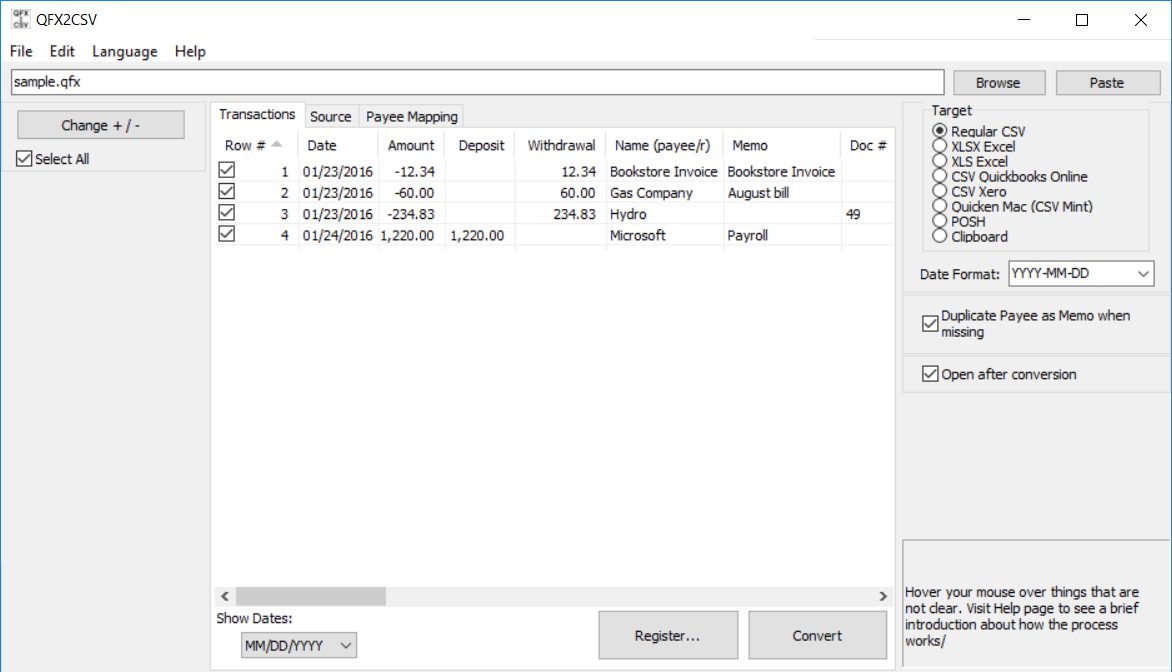Free Download OFX Reader 1.06. A Microsoft Excel add-in for importing OFX, QFX and QBO files. Software Downloads Associated with File Extension QFX: FileViewPro* (free trial download) Quicken Transfer File. Download FileViewPro to Open Your QFX File Now. Learn about QFX files (Recommended software to open QFX files).
What is a QFX file? Files that contain the.qfx file extension are normally associated with the Quicken financial software applications. These QFX files are used to import data into the Quicken application from a user's financial institution or other data sources. QFX files may contain information regarding a user's account balances, transactions and other financial activity. The QFX file format is used by a variety of financial institutions. This allows users to easily import their banking details into the Quicken program. The QFX files can be downloaded by a user by using the Quicken Web Connect feature that is included with the Quicken software.
• What is a file extension? A file extension is the characters after the last dot in a file name.
For example, in the file name 'winmail.dat', the file extension is 'dat'. It helps Windows select the right program to open the file.
• We help you open your file We have a huge database of file extensions (file types) with detailed descriptions. We hand pick programs that we know can open or otherwise handle each specific type of file.

• Original downloads only All software listed on file.org is hosted and delivered directly by the manufacturers. We do not host downloads on our own, but point you to the newest, original downloads.
Let me guess: You are searching for a way to import QFX (typically used for financial programs like Quicken, QuickBooks, or Microsoft Money) into Excel, but have been frustrated because the only thing you seem to find is websites telling you to pay for a utility to do this conversion for you. Well, I have good news: you can do this very easily yourself. It will cost you nothing, and you don’t need anything other than what is already on your computer. WHY I NEEDED TO DO THIS I’ve recent moved away from using Quicken to do my bills, because I realized that I’m spending money every year for a program that lets me do pretty much what my credit union already provides online.
I was spend a lot of time looking at my bills and reconciling accounts and realized something: I was putting all this effort into analyzing my spending after the fact, when what I wanted to do was proactively plan and forecast my spending. WINDOWS USERS: Good news! If you are running Windows and have Microsoft Excel, you can import your QFX files using the steps below.
No third party programs are needed. You will need to do a little work converting the date strings into actual dates in Excel, but this is easily done using the built in Excel functions. Command And Conquer Generals Zero Hour Skirmish Maps Download on this page. MAC USERS: Bad news Microsoft Excel does not properly import XML files and you will likely get the dreaded “This is not a properly formatted XML file” error.
This is a known issue and Microsoft has issued a statement confirming the OSX version of Excel does not have the same XML importing tools as the Windows version. If any Mac users have found a way to get XML into a spreadsheet, please let me know! STEPS TO CONVERT YOUR QFX TO XML STEP 1: Go to your bank’s site and download your transactions. Every bank offers this capability today, so just specify the account(s) you want to download and the time period, and save the QFX file to your computer. STEP 2: Unlike all those commercial companies that make it seem like QFX is a very difficult format to deal with, it really isn’t. It’s actually just a plain vanilla XML file that has a non-standard header! STEP 3: Open the QFX file with a text editor. For Windows users, this will be Notepad.
For Mac users, this is TextEdit. STEP 4: You will see several lines of text, followed by a line that contains.
It will look something like this: OFXHEADER:100 DATA:OFXSGML VERSION:102 SECURITY:NONE ENCODING:USASCII CHARSET:1252 COMPRESSION:NONE OLDFILEUID:NONE NEWFILEUID:NONE The tag is the beginning of the actual XML data that Excel understands, so we just need to get rid of that no-xml info above it. STEP 5: Replace EVERYTHING above the line with this: Now the start of your QFX file looks like this: STEP 6: Save this as a new file, and change the extension from QFX to XML. STEP 7: Open Excel, and then open your new file as an XML Table.